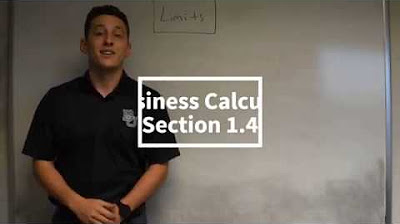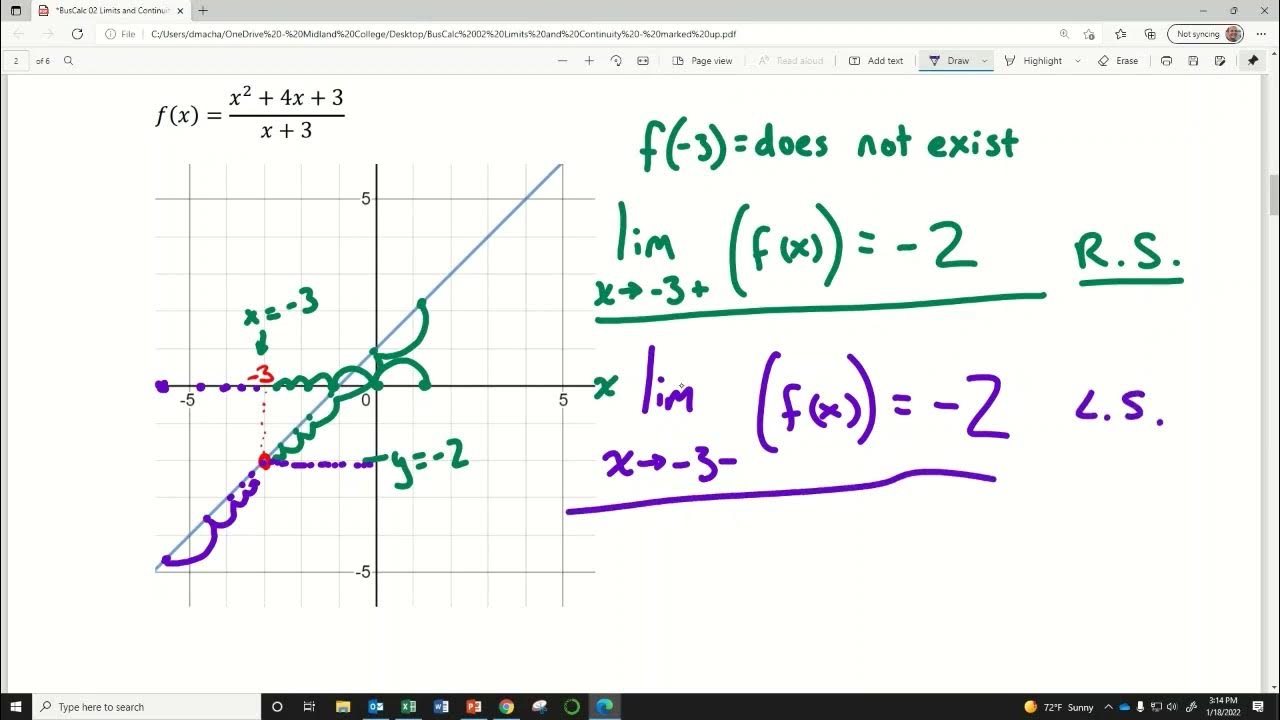Limits via Graphs!
TLDRThis video script is a comprehensive exploration of limits in calculus, specifically focusing on Section 2.2 from Rogowski's fourth edition. The presenter kicks off with an intuitive example of the function y = sin(x)/x, illustrating the concept of limits as the function approaches a certain x-value, even when direct substitution results in an indeterminate form like 0/0. The script delves into the notation and terminology surrounding limits, emphasizing that they are a form of mathematical prediction based on the behavior of a function around a point, rather than at the point itself. The video clarifies that limits are not always defined, as they may result in infinity or discontinuity. It introduces the concept of one-sided limits, which consider the behavior of a function approaching a point from the left or right. The script also touches on infinite limits, explaining how functions may tend towards positive or negative infinity as they approach a certain x-value. The presenter uses various examples, including the function f(x) = 1/(x - 5), to demonstrate how to calculate one-sided limits and how their agreement or disagreement determines the existence of a limit. The video concludes with a teaser for the next topic, which will explore continuous functions and algebraic methods for evaluating limits without the need for graphical representation.
Takeaways
- 📌 Limits are a mathematical concept used to predict the value a function approaches as the input (x) approaches a certain value (c).
- 🔍 The notation for a limit is written as 'lim (x→c) f(x) = l', which means the function f(x) approaches the value l as x approaches c.
- ⚠️ Plugging in the value of x directly into a function can sometimes result in an indeterminate form, like 0/0, which doesn't provide the limit value.
- 👉 Limits can approach a specific number, ±∞ (infinity), or may not exist if the function does not consistently approach a value as x approaches c.
- 🔄 One-sided limits consider only the values from the left or right of c, denoted as 'lim (x→c⁺)' and 'lim (x→c⁻)', respectively.
- 🤝 A limit exists at a point c if both the left and right one-sided limits agree on a common value.
- 🚫 If the one-sided limits do not agree, the limit at that point is said to not exist.
- 📈 Functions can 'blow up' to positive or negative infinity, which is denoted as 'lim (x→c) f(x) = ∞' or 'lim (x→c) f(x) = -∞'.
- 🔢 For continuous functions or points of continuity, you can often find the limit by simply plugging the value of x into the function.
- 📊 Graphing or using a table can help visualize and understand limits, especially when direct substitution results in an indeterminate form.
- 🔍📚 Investigating limits is crucial for understanding calculus as it deals with the behavior of functions near specific points, even when the function is not explicitly defined at those points.
- ➡️ The concept of limits is foundational for topics like continuity, derivatives, and integrals in calculus.
Q & A
What is the main concept of a limit in calculus?
-The main concept of a limit is to determine the value that a function approaches as the input (x) approaches a certain value (c), without necessarily being concerned with the value of the function at that point.
What is an indeterminate form and why is it significant?
-An indeterminate form, such as 0/0, occurs when a function's value is undefined at a certain point, like division by zero. It's significant because it indicates that the limit may exist, but direct substitution is not possible, and other methods must be used to find the limit.
What is the notation used to represent a limit?
-The notation for a limit is written as 'lim (x -> c) f(x) = l', which means the limit of the function f(x) as x approaches the value c is l.
How do one-sided limits differ from regular limits?
-One-sided limits consider the approach to a value from either the left or the right side. They are denoted as 'lim (x -> c⁺) f(x) = l' for the right-hand limit and 'lim (x -> c⁻) f(x) = l' for the left-hand limit. They are used when the function behaves differently on either side of the point c.
What does it mean when a limit does not exist?
-A limit does not exist when the function does not approach a single value as x approaches c. This can happen when the left and right limits disagree, or when the function tends towards infinity or negative infinity.
How can you determine if a function is continuous at a point?
-A function is continuous at a point if the limit exists, the function is defined at that point, and the value of the function at that point is equal to the limit of the function as x approaches that point.
What is the relationship between a function's limit and its behavior as it approaches a vertical asymptote?
-As a function approaches a vertical asymptote, the function's values may tend towards infinity or negative infinity. If the function approaches positive infinity from both sides, the limit is said to be infinity. If it approaches negative infinity from both sides, the limit is negative infinity.
What is the algebraic method to handle a limit where direct substitution results in an indeterminate form like 0/0?
-When direct substitution results in an indeterminate form, algebraic methods such as factoring, canceling common factors, or using special limit laws can be used to simplify the expression and find the limit.
What is the significance of the phrase 'mathematical guessing' in the context of limits?
-The phrase 'mathematical guessing' refers to the process of predicting the value that a function approaches as x approaches a certain value, based on the behavior of the function around that point, rather than at the point itself.
How can you evaluate a limit algebraically if direct substitution is not possible?
-If direct substitution results in an indeterminate form, you can use algebraic techniques such as factorization, rationalization, or applying special limit rules to simplify the expression and find the limit.
What is the role of graphs and tables in understanding limits?
-Graphs and tables can provide a visual representation of how a function behaves as it approaches a certain value, which can help in understanding and predicting limits. However, for continuous functions, limits can often be determined algebraically by direct substitution.
Why is it important to consider one-sided limits when evaluating the limit of a function as x approaches a certain value?
-One-sided limits are important because they allow us to consider the behavior of the function as it approaches a point from the left or right, which is necessary when the function has different behaviors or is not defined at the point of interest.
Outlines
📈 Understanding Limits: Definitions and Examples
This paragraph introduces the concept of limits in calculus, focusing on Section 2.2. The video aims to explain what a limit is, when they are defined, and when they are not. An intuitive example is used to illustrate limits, specifically the function y = sin(x)/x as x approaches 0. The concept of indeterminate forms and the idea that limits are based on the behavior of a function around a point, rather than at the point itself, is discussed. The notation for limits is also introduced, emphasizing that limits are a form of mathematical guessing to determine the value of a function at a certain point based on surrounding points.
🔍 One-Sided Limits and Infinite Limits
This paragraph delves deeper into one-sided limits and infinite limits. The concept of right-hand and left-hand limits is explained, showing how they can differ and lead to the conclusion that a full limit does not exist if the one-sided limits do not agree. Examples are provided to illustrate this, including a function that blows up to infinity as x approaches a certain value. The idea of vertical asymptotes and how they relate to infinite limits is also discussed. The importance of using one-sided limits in certain cases is highlighted.
🔢 Evaluating Limits Algebraically and Continuous Functions
The final paragraph discusses methods for evaluating limits algebraically, without the need for graphs or tables. It emphasizes that for continuous functions, simply plugging in the value of x often yields the correct limit. However, if an indeterminate form like 0/0 is encountered, alternative methods such as graphing may be necessary. The video concludes by summarizing the key idea of limits as mathematical guessing to determine the y-value of a function at a given x-value based on surrounding points. The next video will focus on evaluating limits algebraically for 'nice enough' functions.
Mindmap
Keywords
💡Limit
💡Indeterminate Form
💡One-Sided Limits
💡Continuous Function
💡Plugging In
💡Infinity
💡Vertical Asymptote
💡Piecewise Function
💡Graph
💡xy Table
💡Algebraic Method
Highlights
Investigating limits in calculus involves understanding what a limit is and when it is defined or not.
An intuitive example is provided using the function y = sin(x)/x to demonstrate the concept of limits.
The limit notation is introduced, explaining how to express the limit as x approaches a certain value.
Limits are described as mathematical guessing, based on the behavior of the function around a point, not at the point itself.
Different contexts where limits exist or do not exist are explored, such as functions that tend to infinity or piecewise functions.
The concept of one-sided limits is introduced, explaining how to determine the limit from the left or right.
An example of a function with a hole in the graph is used to illustrate how limits can still be determined around the point.
The importance of agreement between left and right one-sided limits to establish the existence of a full limit is emphasized.
Infinite limits are discussed, showing how functions can blow up to positive or negative infinity.
The function f(x) = 1/x is used as an example to demonstrate one-sided limits approaching positive and negative infinity.
The distinction between full limits and one-sided limits is clarified, with examples of when each is applicable.
The algebraic method of evaluating limits by plugging in the value is introduced as a quick way to find limits for certain functions.
The video emphasizes that if plugging in the value results in an indeterminate form like 0/0, alternative methods such as graphing are required.
Continuous functions and points of continuity are highlighted as scenarios where plugging in the value is always valid.
The video concludes with a teaser for the next topic, which will focus on continuous functions and algebraic methods for evaluating limits.
The presenter encourages viewers to reach out with questions and promises to cover more advanced limit topics in future videos.
Transcripts
5.0 / 5 (0 votes)
Thanks for rating:





